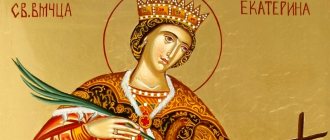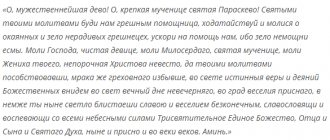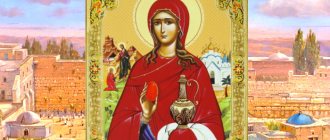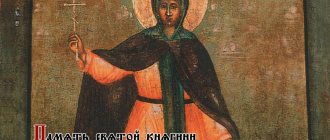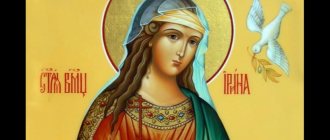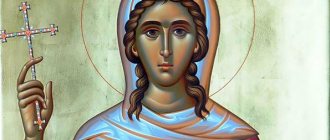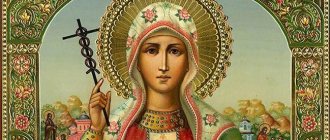On December 7 (November 24, old style) the Church honors the memory of the Holy Great Martyr Catherine . This is one of the most famous and revered Christian saints, both in the Eastern and Western churches. Catherine - “always pure” (translation from Greek), according to her life - the chosen bride of Christ, to whom the Heavenly Bridegroom Himself handed His wedding ring.
Life of the Holy Great Martyr Catherine
Saint Catherine was born in Alexandria in the second half of the third century. She came from a royal family, was remarkably beautiful and famous for her wisdom. Being only eighteen years old, Catherine perfectly studied the works of all pagan writers, ancient poets and philosophers, in addition, she learned oratory and dialectical art and also knew many languages and dialects, so that everyone marveled at her learning and knowledge. Many noble and rich young men sought her hand, but no one could win her favor. When close relatives began to strongly persuade her to agree to marriage, Catherine answered them:
“If you want me to get married, then find me a young man who would possess those four talents with which I, as you know, surpass all other girls; and then I will agree to choose him as my wife; and I don’t want to marry a man who in any way would be worse and inferior to me. So, look everywhere, if you will find a young man who would be like me in the nobility of the family, in wealth, in beauty and in wisdom; Every young man who does not have at least one of these gifts is unworthy of me.
Then her mother, a secret Christian, decided to take her to one holy ascetic, hoping that he would be able to convince her, because regarding beauty and learning they did not hope to find such a chosen one for her. The elder said to her:
- I know one wonderful Youth, Who incomparably surpasses you in all your talents. His beauty is brighter than sunlight; His wisdom governs all sensory and spiritual creatures; the wealth of His treasures is spread throughout the whole world and never decreases, but, as it is distributed, it increases more and more; and the height of His race is indescribable and incomprehensible. There is no one like Him in the whole world.
During the further conversation, the holy elder told Catherine about the secret of the Incarnation and, as a farewell gift, he gave her an icon of the Most Pure Mother of God, instructing her to earnestly pray to the Queen of Heaven if she wanted to see Her Son - That beautiful Youth about whom he told her.
The God-wise young woman, taking the holy icon, returned home and at night, secluded in her room, began to pray as the elder taught her. During a long prayer, she fell asleep from fatigue and saw in a vision the Queen of Heaven together with the Holy Child, surrounded by a radiant radiance. But Catherine could not see His face, for He turned it away from her and turned it to His Mother. Trying to see Him, Catherine came from the other side, but Christ turned His face away from her from there too. This happened three times.
In response to the entreaties of the Mother of God to at least look at Catherine, the Infant God answered Her that this young woman was very darkened and ugly: insane, poor and ugly, and that He could not even look at her until she converted and left her wickedness.
Confused and upset, Catherine hurried to the holy elder’s cell in the morning and told him about her vision. Then the venerable elder revealed to her in detail the entire history of Christian doctrine, starting from the creation of the world and the creation of the forefather Adam until the Second Coming of the Lord Christ to earth, and also told her about the ineffable heavenly glory of the righteous and the painful, endless torment of sinners. His words fell on good and fertile soil: Catherine begged him to immediately perform holy baptism on her, and the elder fulfilled her request with great joy.
That same night she again saw the Queen of Heaven with the Divine Child in her arms. This time the Child looked at Catherine with great kindness and meekness. The Mother of God asked Her Son:
- Is this girl pleasing to You, My Son?
The Lord answered His Most Pure Mother:
- Very pleasing, for now she is beautiful and glorious, and not ugly and dishonest, as before; Now she is rich and wise, and not poor as she was at first; Now I have loved her, and she pleases Me so much that I want to betroth her to Myself as an incorruptible bride.
Then the Lord Christ gave the most beautiful ring to Catherine and said:
“Behold, I now choose you to be My bride, incorruptible and eternal.” So, with great care, preserve this union inviolably and do not choose any earthly groom for yourself.
Having awakened, Catherine really saw a wonderful ring on her right hand - a sign of betrothal to the Heavenly Bridegroom. She felt such joy and joy in her heart that from that hour she surrendered with all her soul to Divine love, leaving all her earthly attachments and cares.
Soon after this, the wicked king Maximian arrived in Antioch, wanting to organize a grand festival in honor of his pagan idols. By his order, people from all over Egypt were to come here for a festive sacrifice. Countless numbers of people gathered, leading oxen or sheep, and those who were poor brought birds or something similar. When the day of the vile celebration arrived, the king sacrificed one hundred and thirty calves - princes and nobles were smaller, and each sacrificed what he could according to his income. The whole city was filled with the cries of slaughtered animals and the stench of sacrifices; everywhere there was terrible crowding and confusion, and the air was saturated with stinking smoke.
Looking at such wickedness, Saint Catherine grieved very much over the error and destruction of so many human souls. Then she decided to enter the shrine, where she publicly denounced the king, speaking about the vanity and wickedness of idol sacrifice.
The king was very surprised and angry, he ordered Catherine to be taken into custody and gathered 50 of the wisest pagan philosophers who were supposed to be able to defeat the saint in speeches or face the shameful death penalty. Hearing the king’s order, one of the most glorious and wise Vitias answered:
“Don’t be afraid, king: our opponent may be unusually smart, but, like a woman, she cannot have wisdom in full perfection and be completely skilled in eloquence; Just tell her to come to us, and you will see that as soon as she sees so many philosophers and speakers, she will immediately be ashamed.
But the Archangel Michael himself appeared to Saint Catherine and promised her:
- Do not be afraid, virgin of the Lord! Your Lord will add more wisdom to your wisdom, and you will win the debate of those fifty revolutions. And not only they, but also many others will believe through you and receive the crown of martyrdom.
Many people gathered to listen to Catherine’s argument with the pagan sages. The oldest philosopher spoke first, who tried to confuse her with his proud and arrogant speech. But Catherine always defeated him with her wise and meek answers, recalling predictions about Christ that could be found in the most ancient pagan authors.
“Listen,” she said to the philosopher, “what your wisest Sibyl says about Him, testifying to His Divine Incarnation and saving crucifixion: “In later times, someone will come to this earth and take upon himself flesh except sin. With the boundless omnipotence of the Divine He will destroy the corruption of unhealed passions and He will be envied by unbelievers, and He will be hanged in a high place, as if worthy of death.” Remember that your sage Apollonius does not confess Christ as God of his own free will, forced to do so by His Divine power: “One,” he says, “the Heavenly One prompts me to confess Him. He is a three-bright light, but God is the one who suffered, but not the Divinity Himself who suffered: for in Him both are both: mortal in the flesh, and at the same time alien to corruption. And this Man, who suffers everything from mortals: the cross, humiliation, burial, is God.” So, believe at least your teachers and gods - Plato, Orpheus and Apollonius, who quite openly and clearly, although against their will, recognized Christ as God.
At the end of the dispute, all the philosophers not only admitted themselves defeated, but also believed in the True God, Whom Saint Catherine professed. The angry king ordered to immediately build a large fire and burn them all in the middle of the city. Seeing this, Catherine encouraged them, strengthening them for martyrdom. In the evening, some pious and Christ-loving people came to bury the remains of the holy martyrs, but they found their bodies completely intact, so that the fire did not even touch their hair. Through this miracle, many of the pagans turned to the knowledge of the truth, and the relics of the holy martyrs were buried with due honor.
Saint Catherine, who was not seduced by the tsar’s lawless speeches, was subjected to cruel scourging on the shoulders and belly, but she endured the torture with such courage that she amazed all those present. After this, the cruel king ordered Catherine to be imprisoned and not to give her any food or drink until he invents new torments to destroy her.
At that time, Maximian had to leave the city for a short time, and his wife, Queen Augusta, who had heard a lot about the wisdom of Catherine, wanted to see her. Having met and talked with Catherine, Augusta came to know the True God and became a Christian.
With the help of God, Saint Catherine quickly recovered from her wounds; every day a dove flew into her window and brought her food. Meanwhile, the king invented a new type of torture for the rebellious girl. He ordered four wooden wheels with sharp iron spikes to be installed on one axle, so that when they rotated they would crush her entire body. But as soon as they began this torment, an angel suddenly descended from heaven, freed the saint from her bonds and broke all the wheels into pieces. Seeing such a glorious miracle, many pagans believed in Christ.
Then Queen Augusta herself began to reproach the king for his inhumanity, for which she immediately suffered torture and martyrdom. Together with her, the Tsar’s senior military commander Porfiry and two hundred of his soldiers, who also turned to faith for the sake of the feat and preaching of Saint Catherine, were executed.
Freed from family ties, the wicked king, still seduced by Catherine’s extraordinary beauty, showed such shameless madness that he did not hesitate to offer her to take the place of the executed Augusta, promising such great benefits and honors as no other queen on earth had ever had. But seeing her unshakable firmness and purity of confession, he finally decided to pronounce a death sentence on her.
The soldiers, having taken Catherine, led her to the place of beheading. Many people, men and women, accompanied Catherine; everyone cried and regretted that such a beautiful and wise maiden was dying. Brought to the place of execution, the saint turned to fervent prayer:
- Lord Jesus Christ, my God! I thank You for placing my feet on the rock of patience and directing my steps. Now stretch out Your most pure hands, once wounded on the cross, and accept my soul, sacrificed to You for the sake of love for You. Remember, Lord, that I am flesh and blood, and do not allow the cruel torturers at the Last Judgment to make clear my sins, committed in ignorance; but wash them with the blood that I shed for You and make this body, wounded in agony for Your sake and truncated with the sword, invisible to my enemies and persecutors. Look down from Thy height, O Lord, upon these people who are coming, and guide them with the light of Thy knowledge; and fulfill the requests of those who call on Your holy name through me for good, so that Your greatness may be sung by all forever.
When the warrior raised his sword and cut off the honest head of Catherine, milk flowed from the wound instead of blood. Her venerable relics, as seen by the worthy believers, were immediately taken by the holy Angels and transferred to Mount Sinai, where a world-famous monastery later arose in the name of the holy great martyr.
Reliquary with the holy relics of the Great Martyr Catherine in the monastery in Sinai
Library of the Russian Faith Teaching in memory of St. Great Martyr Catherine. Great Menaion of Cheti →
Read online in original
Origin of Catherine
Catherine was born at the end of the third century in the city of Alexandria. She was from a royal family. The girl was very smart, she learned many sciences, including medicine and philosophy. But she has not yet tasted the knowledge of true faith. It happened miraculously.
Catherine was very beautiful when she reached marriageable age (at that time people got married from the age of twelve), many grooms wooed her. However, she was in no hurry to give a positive answer. The bride turned out to be very picky. Catherine told her mother that she wanted to have a groom who would equal her in beauty, nobility of the family, wealth, intelligence and education.
The mother, who turned out to be a secret Christian, acted wisely. She took the girl to her spiritual father. He said that he knew such a Groom who was equal to Catherine in intelligence, beauty, education and greatness. Of course, he meant our Lord Jesus Christ, but the girl did not understand this yet.
Veneration of the Holy Great Martyr Catherine
The first mention of the celebration of the memory of St. VMC. Catherine dates back to the 8th century. The veneration of the Holy Great Martyr Catherine is closely connected with the history of the Sinai Monastery, that is, with the earliest history of Christianity, and in Russia it dates back to the times of Kievan Rus. Thus, already in one of the most ancient November menyas (11th century) there is a service for her. The life and martyrdom of the saint were included in the Great Four Mena of St. Macarius and prologues (collections of the lives of saints). Particles of the relics of St. Catherine were contained in 2 reliquaries from the Annunciation Cathedral of the Moscow Kremlin - a pectoral reliquary cross from the 70s. XV century and in the carved folding icon “Praise of the Mother of God” with selected saints on the back (3rd quarter of the 15th century).
Paganism - what does it have to do with our time?
They used to worship statues. Now - to other earthly things. Gucci, iPhone, Coca-Cola, BMW.
Idols and brands: on the one hand, these are incomparable things. But on the other hand, in both cases the same process occurs inside a person. It lies in the fact that the greatest gift that a person has - his desire to unite with God - is directed towards other smaller goals. Happiness for a person is not eternity, but some kind of worldly status. This is not a crime from a criminal point of view, but it is the greatest self-derogation of human dignity. And most often this happens within the framework of an entire civilization, when the entire society as a whole forgets about “heaven”, and puts earthly success and brands at the forefront of everything.
The emperors of those times can indeed be compared to major billionaire businessmen. Christianity became a big problem for the Roman Empire - because the new religion went against all established foundations.
Holy Great Martyr Catherine. Troparion, Kontakion and Canon
The service of the Holy Great Martyr Catherine is not marked with a special holiday sign and is sung together with the service of the post-feast of the Entry of the Most Holy Theotokos and St. martyr Mercury.
Troparion:
With virtues, like the rays of the sun, you enlightened the faithless sages. And like the bright moon walking in the night, you drove away the darkness of unbelief, and you assured the queen, and you also exposed the tormentor, the divinely called bride, blessed Catherine. With the desire to ascend to the heavenly palace, to the Beautiful Bridegroom Christ, and from Him to be crowned with a royal crown. With the angels standing before him, pray for us who are creating your most honorable memory.
Kontakion:
Empress Catherine the Martyr today, and with your orbits denounce the harmful heresy. An angel came from heaven to that one, bringing strength from the Most High. Having already received manly speech, Christ is a martyr’s praise.
Library of the Russian Faith Canon of the Holy Great Martyr Catherine →
Read online
Catherine with the Tsar
When the wicked king and persecutor of Christians Maximin arrived in Alexandria, he built an altar in the middle of the city and ordered all residents to sacrifice to idols. Catherine went to this place, everyone was surprised at her beauty. She asked to tell the king that she had something to tell him.
When the king ordered her to speak, Catherine began to accuse him of iniquities. He asked her to let her finish what she started. After the sacrifice was over, the king called Catherine to him and asked her to repeat what she told him.
Catherine announced to him that she was the royal daughter, had learned a lot, and that making sacrifices to soulless idols was a lawless thing, that one must believe in the True God. He got angry, ordered to guard the maiden, and ordered his wise men to compete in teachings with Catherine. They were confident that they would defeat the weak girl with their minds. But it turned out not to be so.
Before Catherine was brought before the wise men, Archangel Michael appeared and assured her that she could defeat them in the competition, and they would turn to Christ and accept martyrdom. Fifty wise men appeared before the assembled people. They were going to compete in wits with Catherine.
When they talked, the girl was able to defeat them in reason and convert the wise men to Christ. The king ordered them to be burned in the middle of the city. She baptized them and convinced them not to be afraid of martyrdom, because for this they would receive Heavenly reward. The sages gladly went to the fire.
Folk traditions on the day of the Holy Great Martyr Catherine
The name of the Holy Great Martyr Catherine was very popular among other female names, especially in our time, so the name day is a very noticeable event in the church calendar, rightfully decorating the modest Lenten meal with rich, festive pies.
Previously, the so-called Catherine’s festivities were very popular among the people. On this day it was impossible to sit at home, the whole village had to have fun and rejoice. In Rus', young people rode sleds down hills and on horse-drawn sleighs. The grooms tried to look for a good bride during the festivities so that they could have a wedding during the winter meat-eater. The girls, in turn, asked the saint to find a good and worthy groom.
People also turn to the holy great martyr for help during pregnancy and difficult childbirth. In the West, she is considered the patroness of students and all students, like Saint Tatiana in Russia.
Holy Great Martyr Catherine. Icons
“Iconographic original”, compiled at the beginning of the 20th century by S.T. Bolshakov, based on the originals of the 16th century, reports that Saint Catherine is depicted as follows: “On her head is a royal crown, her hair is as simple as a maiden’s, an azure robe, cinnabar underwear (red underwear), royal barmas (precious decorations on clothes) to the hem, and on the shoulders and on the sleeves, the sleeves are wide, in the right hand there is a Cross, and in the left hand there is a scroll, and in it he writes: “Lord God, hear me, grant remission of sins to those who remember the name of Catherine, and at the hour of his departure, see him off in peace and grant his place is at peace."
Thus, only without the scroll, she is depicted in an early 13th-century icon from the monastery of St. Catherine on Mount Sinai. Perhaps it was this icon that served as the main temple image and was located near the shrine with the relics of the saint.
Saint Catherine with her life. Beginning of the 13th century Monastery of St. Catherine on Mount Sinai
Sometimes Saint Catherine is depicted wearing a red cloak, the traditional attire of martyrs, and a blue tunic. The head of the saint may be covered with a white cloth, symbolizing chastity, spiritual and physical purity.
Holy Great Martyr Catherine. Monastery of St. Catherine Great Martyr Catherine with her life. Mid-17th century Yaroslavl
Holy Great Martyrs Catherine, Varvara and Paraskovea. Monastery of St. Catherine
In the 16th century, a new iconographic version appeared in Russian art - “Prayer of the Great Martyr Catherine for the People”, not found in Byzantine or Balkan art. The saint is depicted with a scroll in her hand containing the text of her dying prayer; behind Catherine is an executioner with a sword; sometimes the wheel and fortifications of Alexandria are depicted nearby.
Prayer of the Great Martyr Catherine for the people. Rus', 16th century
Probably, this iconography arose due to the veneration of St. Catherine as an intercessor “at the exodus of the soul”: before her execution, she prayed to the Lord to forgive all the sins of those who would remember her before death. Sometimes kneeling believers are depicted at the saint’s feet, resorting to her prayerful intercession.
Conversion of Catherine, meeting with the Mother of God and Christ
The girl wanted to see that Wonderful Groom about whom her confessor . Then he gave her icons of the Most Holy Theotokos, telling her to beg the Woman depicted on the icon to show Catherine her Son.
Catherine did just that, she placed the image in her room and asked the Mother of God to show her Her Son. In a dream, the Most Holy Theotokos and the Child appeared to a girl, but she could not see His face because He was turning away from her. The Most Pure One asked Christ to show His face to the beautiful girl, but He replied that to Him she was ugly because she had not yet been enlightened by the Light of Truth.
Catherine woke up in bewilderment. She went to her confessor, telling him her dream. He taught the girl the basics of faith and then offered to accept Holy Baptism. After the Sacrament, Catherine tearfully begged the Most Pure One to appear to her again.
In a dream, the girl again saw the Most Holy Theotokos with Her Son, who no longer turned away from her.
The Mother of God asked:
- My son, now do you please this girl? Doesn't she seem ugly to you anymore?
- Now she is beautiful! And I call her My bride.
Christ handed Catherine a wonderful ring in a dream and put it on her hand. Waking up, the girl saw that same ring on her hand. Her soul was filled with happiness.
Temples in honor of the Holy Great Martyr Catherine
Currently, there are up to 300 churches in the name of the Holy Great Martyr Catherine , both in Russia itself and abroad: in Finland, Italy, Hungary, Romania, Cyprus, Turkey and Egypt.
Among the most ancient buildings in Rus', the Novgorod Church in honor of the Great Martyr is known; it is mentioned in the list of wooden churches that burned down in 1310; later (from the turn of the 14th and 15th centuries) it appears as a stone chapel of the Church of the Assumption at Torg.
The history of the first Moscow church of the Great Martyr Catherine begins at the end of the 16th century, when a craft settlement appeared on Vspolye (Bolshaya Ordynka Street), established through the efforts of Anastasia Romanovna, the first wife of Tsar Ivan the Terrible. She also built a wooden temple here, known from chronicles of 1612.
Church of the Great Martyr Catherine on Bolshaya Ordynka. Photo from 1883 (south side)
The Church of the Great Martyr Catherine, on the Tsaritsyny Entrance (Moscow), was built under the Church of the Resurrection of the Word in 1627. As the chronicle says, in 1536 there was a wooden church on this site, but in 1626 it was destroyed by fire. Thanks to wooden passages, in the 17th century the church was combined with the royal mansions of the Terem Palace. In the 19th century, the interiors of the temple were completely changed, and restoration was carried out in the 20s and 60s of the 20th century. Today, free entry to the church is closed.
Northern façade of the Terem Palace. At the top is the Church of the Resurrection of the Word, at the bottom (with an arcade) is the Church of Catherine
The Monastery of St. Catherine is one of the oldest continuously operating Christian monasteries in the world, founded in the 4th century in the center of the Sinai Peninsula. Among the abbots of the monastery, the most famous is St. John Climacus. Initially it was called the Monastery of the Transfiguration or the Burning Bush. After the discovery of the relics of St. Catherine and the spread of her veneration, by the 11th century the monastery acquired its present name - the Monastery of St. Catherine.
Old Believer churches in honor of the Holy Great Martyr Catherine
In honor of the Holy Great Martyr Catherine, a church of the Russian Orthodox Church in the village of Glazovo, Moscow region, was consecrated.
Church of the Great Martyr Catherine. Glazovo
The Russian Ancient Orthodox Church owns the bell tower of the Church of the Holy Great Martyr Catherine in Moscow.
Bell tower of the Old Believer Church of St. Catherine. Moscow
What can you ask for in front of the image of a martyr?
What did the great martyr want? She said that she was looking for an equal. A husband who would surpass her in all characteristics.
Patronage of relationships and marriage
First of all, you need to ask the saint to help you find a worthy companion or life partner. Girls and boys who have not yet gotten married ask for this.
You can ask Catherine to strengthen family relationships, help save the marriage, the saint will help.
Helps in getting rid of loneliness
Not everyone likes living alone. Catherine can help you meet a companion who will be your support. An understanding, kind person will match all the spiritual qualities of the person asking.
Believe in Christ
You can’t argue with the fact that the queen, having converted to Christianity, sincerely believed in God. She carried this faith and kept it until her death. Catherine was not afraid of death; she was strengthened by the belief that God would help in difficult times. If a person is desperate and is in a difficult situation, then he should read a prayer to St. Catherine.
Birthday city
On December 7, the city of Yekaterinburg solemnly and increasingly actively celebrates its name days over the years. And the community of the Old Believer Church in the name of the Nativity of Christ in Yekaterinburg on this day celebrates, as it were, the second throne. Due to the impossibility of coming to Yekaterinburg on the day of the patronal feast, on the Nativity of Christ, for several years now believers from all over the area have been gathering here a month earlier, on the day of remembrance of St. Catherine, who gave the name to the city.
The city was founded in 1723 as the capital of the mining region. The name of the city was given in honor of Catherine the First. During the reign of Catherine II, the main road of the Russian Empire, the Siberian Highway, was built through the city. Yekaterinburg became the key city to the vast and rich Siberia, a “window to Asia,” just as St. Petersburg was the Russian “window to Europe.”
Today Ekaterinburg is the fourth most populous city (after Moscow, St. Petersburg and Novosibirsk) in Russia.
Martyr's Trials
The preacher was beaten with whips for several days, and then thrown into prison, deprived of food and drink. All this time she remained faithful to the Lord, which aroused sincere admiration among the common people. Even the emperor's wife did not remain indifferent. One day she had a dream about St. Catherine places the Divine Crown on her head. In the morning, together with the military leader Porfiry, the empress went to the captive to talk. A short meeting led to the fact that the martyr converted them to the Christian faith, telling them about the Grace of the Kingdom of Heaven.
Christ did not forget about His bride, who appeared to her every day in the form of a snow-white dove bringing food. When the exhausted girl was about to be cut on the wheel, an Angel suddenly appeared and smashed the terrible weapon with his sword, which killed the executioners with its fragments.
The miracle of salvation, which occurred in front of a crowd of thousands, became a turning point in the conversion of the Alexandrians to the faith of Christ.
After the failed execution, Maximin ordered the preacher’s head to be cut off, but even then her body was saved from desecration. When the executioner lowered the ax, milk flowed from the wound on the girl’s neck, after which the angels who appeared took the remains to the sacred Mount Sinai.
